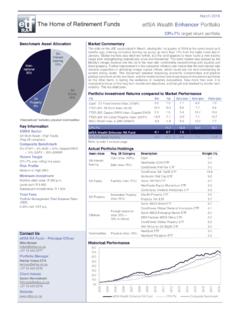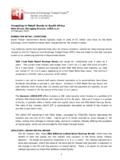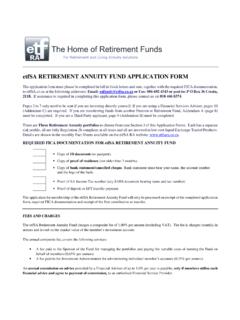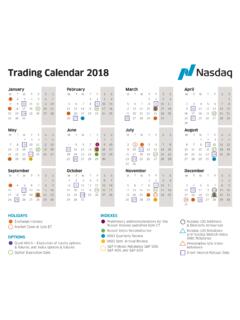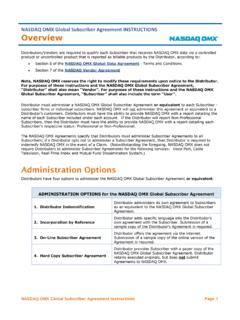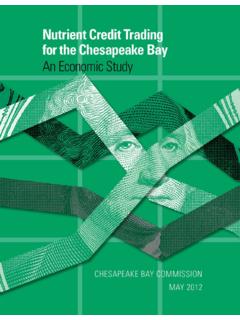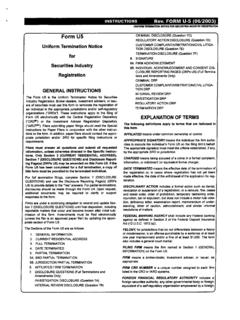Transcription of Information sheet Satrix Nasdaq 100 ETF - etfsa.co.za
1 Information sheetSatrix Nasdaq 100 ETFA pril 2018 Investment MandateThe objective of the Satrix Nasdaq 100 ETF is to provide an investment vehicle for investors wishing to track the performance of the Nasdaq 100 index ( benchmark index ). This will be achieved by investing in the iShares Nasdaq 100 UCITS ETF ( underlying fund ) investment objective of the underlying fund is to provide investors with a total return, taking into account both capital and income returns, which reflects the return of the Nasdaq -100 index. In order to achieve this investment objective, the investment policy of the underlying fund is to invest in a portfolio of equity securities that replicates the component securities of the benchmark index. Further Information on the underlying fund can be obtained directly from the following iShares website: iShares Nasdaq 100 UCITS ETFThe Nasdaq -100 index is a market cap weighted index that includes the largest 100 non-financial companies on the Nasdaq Stock SpecificsRisk Profile (High)This is a high-risk portfolio that aims to deliver capital growth over the long term (greater than 5 years).
2 The fund will primarily invest in offshore equity markets and will be exposed to currency exchange rate fluctuations. This fund is suited to investors with an aggressive risk profile who are looking for longer-term capital growth from offshore exposure and who understand the potential for increased volatility that comes from investing in an index with a narrower focus, namely innovative companies with a strong focus on technology InformationCategoryExchange Traded FundCurrencyZART argeted Total Expense Ratio(TER)* Frequency**No distributionBenchmarkNasdaq-100 IndexFund classificationRegional-Equity-GeneralTra nsaction cut off timePlatform dependentValuation time of fund17:00 Daily price settlementT+3 Custodian / TrusteesStandard Chartered Bank* TheTotal Expense Ratio (TER) will be targeted at will be calculated after 1 year.**The underlying fund reinvests the income received from the constituents in the index through the purchase of securities comprising the index and therefore does not Investment PlanNo MinimumsInvest any amountyou chooseMonthly Debit Order: R300 Lump Sum: R1000 Satrix Nasdaq 100 ETF securities can also be bought and sold directly through stockbrokers by both retail and institutional investors.
3 Initial fees and other costs will be negotiated with the specific Investment feeNo fee chargeNofee chargeRecurringinvestment administration feeNo fee charge0,35% - 0,60%(dependingon size of investment)Top 10 holdings of the iShares Nasdaq 100 UCITS ETFS ecurities% of PortfolioApple A IncClass IncClass Corporation A : iSharesas 31 March 2018 USD Return of the iShares Nasdaq 100 UCITS ETF | 31 Mar 20181 year3 Years5 YearsSince inception(January 2010) Information : Satrix Managers (RF) Pty Ltd (Reg. No. 2004/009205/07). Building 2, 4th floor, 11 Alice Lane, Sandton, Box 653477, Benmore, 2010. Tel 086 110 0670 Web: E-mail: in this ETFThis ETF is listed on the JSE and allows you access to the Nasdag100 companies in ZAR. You will gain niche exposure to global companies on the forefront of innovation across various sectors, but with a strong focus on the technology (ex VAT)Minimum InvestmentPerformance is shown on a Net Asset Value (NAV) basis, with gross income reinvested where applicable.
4 Performance data is based on the net asset value (NAV) of the ETF which may not be the same as the market price of the ETF. Individual shareholders may realize returns that are different to the NAV : BlackRockInvestors in the Satrix Nasdaq 100 ETF will get a ZAR return and must be aware of the effect the USD/ZAR exchange rate can have on sheetSatrix Nasdaq 100 ETFA pril 2018 PortfolioManagersThe management of investments are outsourced to Sanlam Investment Management (Pty) Ltd, FSP 579, an authorised Financial Services Provider under the Financial Advisory and Intermediary Services Act, 2002 Index SpecificsContactInformationSatrixNOW Call centre010 020 2250 | Email Investment Plan call centre 086 110 0670 | Email AdditionalInformationManager Information : Satrix Managers (RF) Pty Ltd (Reg. No. 2004/009205/07). Building 2, 4th floor, 11 Alice Lane, Sandton, Box 653477, Benmore, 2010. Tel 086 110 0670 Web: E-mail: Satrix Investment TeamStandard Chartered Bank 011 217 6600 | E-mail: (RF)(Pty)Ltd( Satrix )isanauthorisedFinanc ialServicesProvider(FSPNo.)
5 15658)anda registeredandapprovedmanagerofCollective InvestmentSchemes(CIS)in termsof theCollectiveInvestmentSchemesControlAct , ( Satrix securities),whileregisteredasCIS,arelist edontheJSEL imited,tradeatJSErulingpricesviaanystock brokerortradingplatform, indicativeandis ,themarketpriceofSATRIX securitieswillfluctuateaccordingtomarket conditions,generalsentimentandotherfacto rs. Pastperformanceisnotnecessarilya guidetofutureperformancenordoestheManage rprovideanyguaranteewithrespecttothecapi talinvested,northereturnofa (CIS) s,brochures,applicationforms,scheduleoff ees,chargesandcommissions,annualandquart erlyreports,canbeobtainedfromtheManager. Shouldtheuserofthisdocumentseekfinancial ,tax,legal,and/oraccountingadvice, investment -Passive investment is a style of investing where a fund replicates the performance a particular market index. Passive investment vehicles include Exchange Traded Funds (ETF s) and index tracking unit trusts. They are so called because the portfolio manager doesn t choose the underlying portfolio.
6 They simply replicate the index they have chosen to track.*Total Expense Ratio (TER) -This is the total costs associated with managing and operating an investment (excluding administration, financial planning and servicing fees). These costs consist primarily of management fees and additional expenses such as trading fees, legal fees, auditor fees and other operational expenses. The total cost of the fund is divided by the fund's total assets under management to arrive at a percentage amount, which represents the TER. The TER is expressed as a percentage of the daily NAV of the CIS and calculated over a period of 1 year on an annualised (TC) TheTransactionCostis thecostthatwillbeincurredbytheportfolioi nthebuyingandsellingofunderlyingassets. ThisisexpressedasapercentageofthedailyNA VoftheCISandcalculatedovera periodof1 -Volatility is a measure of risk , and refers to the extent to which the price of an investment or fund fluctuates over a certain period of time. Funds with a high volatility usually offer the potential for higher returns over the longer term than low volatility funds but also the potential for significant -A portfolio of securities comprising all the component securities of the relevant index in the same weighting as they are held on that -A constituent is an instrument which is part of a larger portfolioCentral Securities Depository Participant (CSDP) -Institution established to hold securities and to affect transfer under section 32 of the Securities Services Act, No 36 of 2004 between accounts, typically by -Liquidity is the ease of buying and selling a financial instrument for cash without causing any significant change in its highdegreeofliquiditythroughcontinuously offeringtobuyandsellparticipatoryinteres tsatpricesaroundtheNAV, Asset Value (NAV) -The NAV is the total assets of the portfolio less the liabilities.
7 The NAV is given per ETF share that is outstanding by dividing the total value of the fund by the number of shares that are risk -Investing South African Rand (ZAR) to access US dollar based indices means you are exposed to exchange rate risk. Your performance will be positively affected if the rand weakens against the dollar, and negatively affected if the rand lending -The lending of securities from one party (being the holder of the securities) to another party (the borrower). The borrower provides collateral for the securities -An instrument representing ownership (stocks), a debt agreement (bonds) or the rights to ownership (derivatives).Spread -The difference between the yield at which a market maker is willing to buy a security and the yield at which the seller is willing to sell it (the difference between the bid and ask for a given security).Stockbrokers -A stockbroker can execute your purchase or sale order through the JSE s trading system (stockbrokers need to be registered members of the JSE).
8 As with any share transaction, your broker will attempt to find a sell order for your securities in the market that match against your buy electronic settlement system utilised by the JSE and administered by Strate, which facilitates the electronic clearing and settlement for all transactions concluded on the Traded Funds (ETF) vs Unit Trust -Both Unit Trusts and ETF s the investor essentially owns a proportionate share (in proportion to the participatory interest held in the fund/portfolio) of the underlying investments held by the fund. With Unit Trusts, the investor holds participatory units issued by the fund while in the case of an EFT, the participatory interest, while issued by the fund, comprises a listed security or share and traded on a Johannesburg stock exchange. ETF shares can be traded by any stockbroker on the exchange or via the Satrix Investment Plan.



